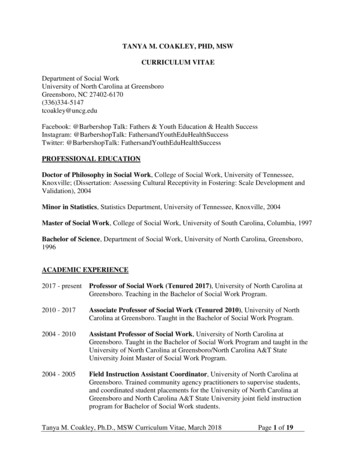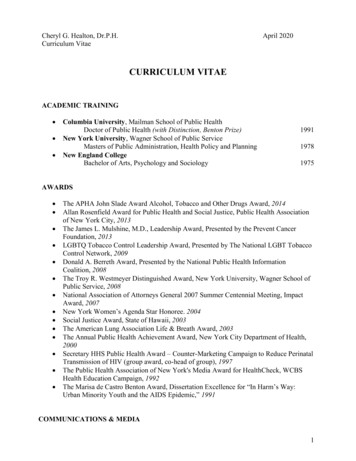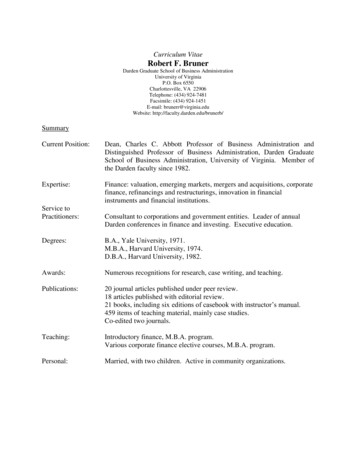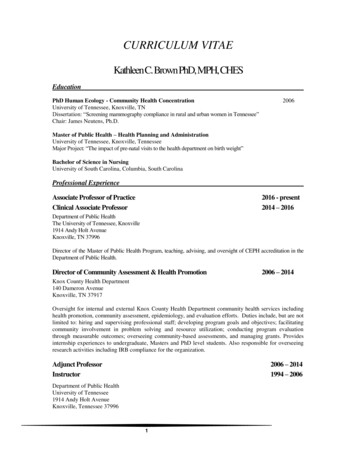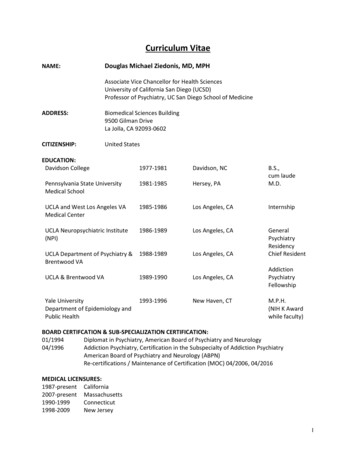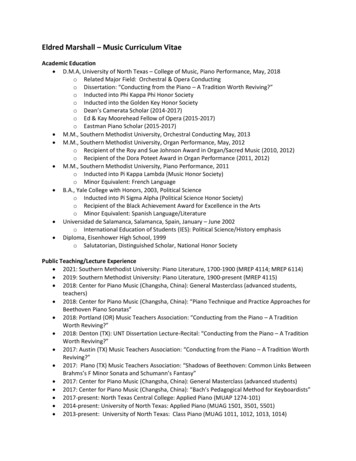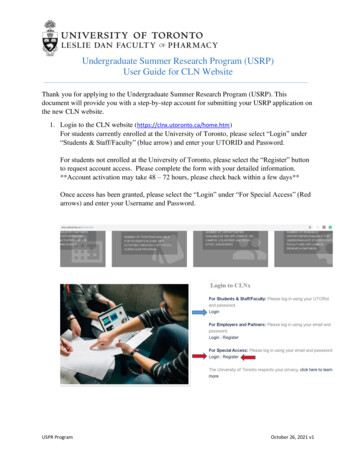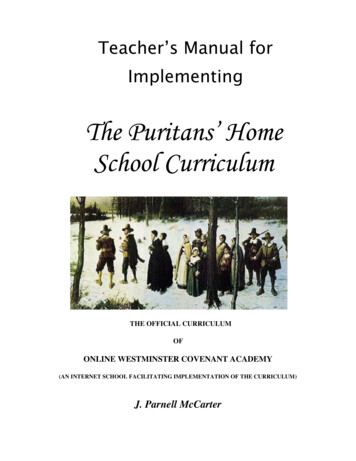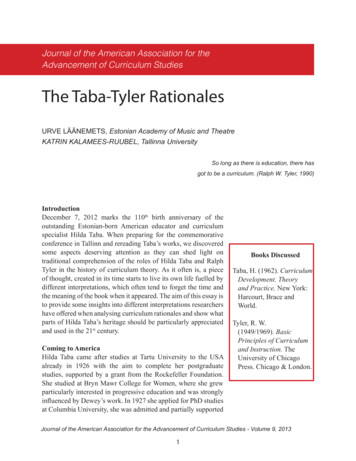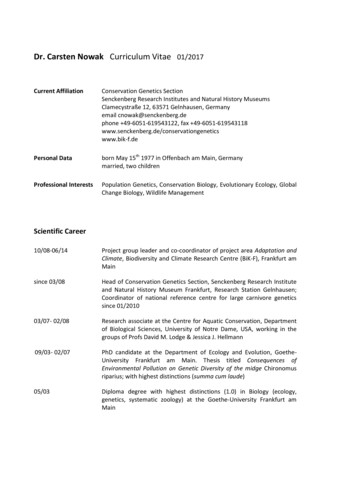
Transcription
Dr. Carsten Nowak Curriculum Vitae 01/2017Current AffiliationConservation Genetics SectionSenckenberg Research Institutes and Natural History MuseumsClamecystraße 12, 63571 Gelnhausen, Germanyemail cnowak@senckenberg.dephone 49-6051-619543122, fax neticswww.bik-f.dePersonal Databorn May 15th 1977 in Offenbach am Main, Germanymarried, two childrenProfessional InterestsPopulation Genetics, Conservation Biology, Evolutionary Ecology, GlobalChange Biology, Wildlife ManagementScientific Career10/08-06/14Project group leader and co-coordinator of project area Adaptation andClimate, Biodiversity and Climate Research Centre (BiK-F), Frankfurt amMainsince 03/08Head of Conservation Genetics Section, Senckenberg Research Instituteand Natural History Museum Frankfurt, Research Station Gelnhausen;Coordinator of national reference centre for large carnivore geneticssince 01/201003/07- 02/08Research associate at the Centre for Aquatic Conservation, Departmentof Biological Sciences, University of Notre Dame, USA, working in thegroups of Profs David M. Lodge & Jessica J. Hellmann09/03- 02/07PhD candidate at the Department of Ecology and Evolution, GoetheUniversity Frankfurt am Main. Thesis titled Consequences ofEnvironmental Pollution on Genetic Diversity of the midge Chironomusriparius; with highest distinctions (summa cum laude)05/03Diploma degree with highest distinctions (1.0) in Biology (ecology,genetics, systematic zoology) at the Goethe-University Frankfurt amMain
Scientific & Societal Service Member of the „Dokumentations- und Beratungsstelle des Bundes zum Thema Wolf“(DBBW) (since 12/2015) Coordinator of the national reference center for genetic analyses of large carnivores(since 01/2010) Organizer of scientific conferences and workshops (86th annual conference of the GermanSociety of Mammalogy “The Past, Present, and Future of Mammalian Diversity”,Senckenberg Natural History Museum, Frankfurt am Main 2012; 2nd Meeting of theEuropean Wildcat Consortium, Gelnhausen 2014; 1st CEwolf consortium meeting,Gelnhausen 2014) Providing genetic species identification service with 15.000 species identifications forNGOs, conservation agencies, citizen scientists and research institutions (2008- ongoing) Founding member of the Central European Wolf Genetics Consortium (CEwolf,www.senckenberg.de/cewolf) Member of the National Park and UNESCO world heritage site Kellerwald-Ederseeadvisory council Regular environmental education activities and open events for school classes, students,and the public at the Gelnhausen Research Station & involvement in citizen scienceprojects (e.g., Wildkatzensprung, www.bund.net/wildkatzensprung) Hosting of international students in the frame of the Minority Health and HealthDisparities International Research Training (MHIRT) program of the University ofCalifornia at Santa Cruz, USA Author or coauthor on 140 conference contributions and public talks.Teaching & SupervisionPhD Theses Joao Pedrosa, Universidade de Aveiro, Portugal, with Prof. A. Soares (2012-2016 expected)Master/Diploma Theses Marc Büntjen, Philipps-Universität Marburg, with Prof. L. Beck (2009): Entwicklung einesnichtinvasiven genetischen Markersystems zur Identifikation europäischer Säugetiere Michael Bauer, Ernst-Moritz-Arndt-Universität Greifswald, with Prof. K. Fischer (2011):Development of an eDNA based method for highly sensitive detection of freshwater species Stefanie Hartmann, Ernst-Moritz-Arndt-Universität Greifswald, with Prof. K. Fischer (2011):Regional population structure of the European wildcat (Felis silvestris) - a landscape geneticsapproach
Thorsten Haver, Justus-Liebig-Universität Gießen, with Prof. V. Wolters (2012):Gefährdungspotential, Erhaltungszustand und der räumliche Effekt von Schutzmaßnahmen fürden Feldhamster (Cricetus cricetus) in Hessen. Melanie Albert, Justus-Liebig-Universität Gießen, with Prof. V. Wolters (2013): Erfassung desReproduktionserfolges des Feldhamsters (Cricetus cricetus) in Hessen. Martina Buhrmester, Philipps-Universität Marburg, with Prof. L. Beck (2013): Stable,noninvasive methods for species distinction in Canis sp. Michel Schleenbecker, Justus-Liebig-Universität Gießen, with Prof. V. Wolters (2014):Verbesserung von Methoden zur Bestimmung von Populationsgrößen undBestandsentwicklungen bei Feldhamstern.Theses performed in my group with external supervision Melanie Fuchs, Bachelor thesis, Goethe-Universität Frankfurt, Prof. A. Janke (2014)Katharina Steyer, Diploma thesis, Goethe-Universität Frankfurt, Prof. B. Streit (2009)Laura Tippel, Diploma thesis, Gutenberg-Universität Mainz, Prof. J. Kadereit (2011)Susanne Carl, Diploma thesis, Goethe-Universität Frankfurt, Prof. B. Streit (2011)Claudia Herröder, Diploma thesis, Goethe-Universität Frankfurt, Prof. B. Streit (2012)Timo Talke, Master thesis, Goethe-Universität Frankfurt, Prof. B. Streit (2016- open)Anna Kasperkiewicz, Master thesis, Goethe-Universität Frankfurt, Prof. A. Janke (2016)Katharina Reinert, Master thesis, Goethe-Universität Frankfurt, Prof. Hickler (2016- open)Jutta Geismar, PhD thesis, Goethe-Universität Frankfurt, Prof. P. Haase (2010-open)Christiane Frosch, PhD thesis, Goethe-Universität Frankfurt, Prof. M. Pfenninger (2010-14)Verena Harms, PhD thesis, Goethe-Universität Frankfurt, Prof. A. Janke (2010- open)Katharina Steyer, PhD thesis, Goethe-Universität Frankfurt, Prof. B. Streit (2011-17)Claudia Wittwer, PhD thesis, Goethe-Universität Frankfurt, Prof. M. Thines (2013- 2017)Annika Tiesmeyer, PhD thesis, Goethe-Universität Frankfurt, Prof. M. Pfenninger (2014- open)Anne Jarausch, PhD thesis, Goethe-Universität Frankfurt, Prof. T. Müller (2015-open)Alina von Thaden, PhD thesis, Goethe-Universität Frankfurt, Prof. A. Janke (2015- open)Tobias E Reiners, PhD thesis, Goethe-Universität Frankfurt, Prof. A. Janke (2012-16 expected)Courses Master module Evolutionsbiologie aquatischer Organismen, Goethe-Universität Frankfurt, FBBiowissenschaften, 5 weeks, 2010, 2014. Undergraduate module with field excursions Diversität der Organismen und Lebensräume,Goethe-Universität Frankfurt, FB Biowissenschaften, 2015, 2016. Regular offer of practical courses, both universitary and non-university; hosting students andyoung scientists from various universities and institutions: Barcelona (Autonomous University),Budapest (Natural History Museum), Fairfax (George Mason University), Frankfurt, Gießen,Greifswald, Leipzig, Mainz, Marburg, Murcia, Porto (CIBIO), Salt Lake City (University of Utah),Tlemcen (Algeria), Tunis (El Manar University), Vienna (Boku), Würzburg
Grants ( 3,88 M since 2008)Entwicklung eines Konzepts zur Übertragung von Daten aus dem genetischen Monitoring derWildkatze für den FFH-Bericht 2019 (2016)Estimating genetic and demographic parameters of the Romanian wolf population, WOLFLIFEproject (LIFE13NAT/RO/000205) (2015-2017)eDNA-basierter Nachweis von Maifischen, HIT-Umwelt- und Naturschutzstiftung, with Dr. StefanStoll (2014)Entwicklung, Etablierung und Anwendung einer kostengünstigen, flächendeckend einsetzbarenMethode zur Detektion der Krebspest mittels environmental DNA, with Dr. Stefan Stoll & Prof.Marco Thines (2014)Erfassung und Reproduktionserfolg beim Feldhamster in Hessen. Deutsche Wildtierstiftung, withTobias E Reiners (2014)Genetische Untersuchungen zur Herkunftsanalyse der hessischen Fischottervorkommen.Regierungspräsidium Darmstadt (2014)Entwicklung einer Gendatenbank für die Wildkatze. Bundesprogramm Biologische Vielfalt (20122017), with Lothar Menner & Bund für Umwelt und Naturschutz Deutschland (BUND)Development and implementation of genetic methods for determination of the status of the wildanimals: Brown bear, wolf, lynx, and wild cat. Bulgarian Ministry of the Environment (20122014)Experimentelle Populationsgenomik der lokalen Adaptation von Chironomus riparius, DeutscheForschungsgemeinschaft (DFG), with Prof. Markus Pfenninger & Prof. Tom Hankeln (2013)Wildkatzensprung – Genetisches Begleitmonitoring im Rahmen des BUND-Projekts zum Schutzder Wildkatze in Deutschland. Bundesprogramm Biologische Vielfalt (2012-2017)Development and application of microsatellite markers for the Saiga antelope. Royal Society forthe Protection of Birds (2012)Genetische Analyse von Haselhühnern (Bonasa bonasia) zur Unterscheidung von Unterarten.Staatliche Vogelwarte Frankfurt am Main (2012)Inferring genetic patterns of ongoing recolonization of Central Europe by elusive, large carnivoresusing novel SNP marker systems for noninvasive samples. SAW Research Initiative of theLeibniz Gemeinschaft (2011-2014)Using hair traps for genetic beaver monitoring in Hesse. Regierungspräsidium Darmstadt (2011)Importance of genetic diversity for populations under climate change. Hessian Initiative forExcellence in Economy & Science (LOEWE) (2011-2014)Development of a genetic detection system for predator identification from kills. Hessian Ministryof Environment and Agriculture (HMUELV) (2010)Genetic large carnivore monitoring in Germany. Diverse funding sources (2010-ongoing)Estimating losses in genetic diversity under climate change. Hessian Initiative for Excellence inEconomy & Science (LOEWE) (2009)Development of a genetic marker system for non-invasive assessment of dispersal, relatednessand hybridization in the European beaver. Regierungspräsidium Darmstadt (2009)DNA-based population size estimation of wildcats in the Taunus mountain range. FENA (2009)A Bayesian model based approach for the assessment of dispersal in aquatic insects. DeutscheForschungsgemeinschaft (DFG), with Prof. Peter Haase (2009-2012)
Molecular taxonomy of the Egyptian goose (Alopochen aegyptiacus). Hessian Ministry ofEnvironment and Agriculture (HMUELV), 2,000 (2009)Assessing the genetic population structure of montane insects – a global change genetic approach(BiK-F project code C5.2). Hessian Initiative for Excellence in Economy & Science (LOEWE),150,000 (2009-2012)Wildlife genotyping service. Diverse funding sources, 885,000 , (2008-ongoing)ISI Publications (GoogleScholar H 19, 1340 citations as of August 15 2017)63. Von Thaden, Cocchiararo B, Jarausch A, Jüngling H, Karamanlisis AA, Tiesmeyer A, Nowak C,Munoz-Fuentes V: Assessing SNP genotyping of noninvasively collected wildlife samples usingmicrofluidic arrays. Nature Scientific Reports, accepted.62. Bayerl H, Kraus RHS, Nowak C, Foerster DW, Fickel J, Kuehn R: Fast and cost-effective singlenucleotide polymorphism (SNP) detection in the absence of a reference genome using semideep next generation random amplicon sequencing (RAMseq). Molecular Ecology Resources,accepted.61. Steyer K, Tiesmeyer A, Munoz-Fuentes V, Nowak C: Low rates of hybridization betweenEuropean wildcats and domestic cats in a human dominated landscape. Ecology & Evolution,accepted.60. Eddine A, Mostefai N, De Smet K, Klees D, Ansorge H, Karssene Y, Nowak C, Van Der Leer P:Diet composition of a newly recognized canid species, the African golden wolf (Canis anthus),in northern Algeria. Annales Zoologici Fennici 54, 347-356.59. Pedrosa J, Cocchiararo B, Verdelhos T, Soares AM, Pestana JLT, Nowak C (2017) Populationgenetic structure and hybridization patterns in the cryptic sister species Chironomus ripariusand C. piger across differentially polluted freshwater systems. Ecotoxicology andEnvironmental Safety 141, 280-289.58. Barnosky AD, Hadly EA, Gonzalez P, Head J, Polly PD, Lawing AM, Eronen JT, Ackerly DD, AlexK, Biber E, Blois J, Brashares J, Ceballos G, Davis E, Dietl GP, Dirzo R, Doremus H, Fortelius M,Greene H, Hellmann J, Hickler T, Jackson ST, Kemp M, Koch PL, Kremen C, Lindsey EL, Looy C,Marshall CR, Mendenhall C, Mulch A, Mychajliw AM, Nowak C, Ramakrishnan U, Schnitzler J,Kashish DS, Solari K, Stegner L, Allison Stegner M, Stenseth NC, Wake MH, Zhang Z (2017) NoGoing Back: Merging paleontology with conservation biology to guide the future of terrestrialecosystems. Science 355, eaah4787.57. Pedrosa J, Machado AL, Cocchiararo B, Soares AMVM, Nowak C, Pestana JLT (2017) Assessingthe suitability of genetic diversity of Chironomus riparius (Meigen) as an indicator ofenvironmental pollution. Ecological Indicators 78, 115-124.56. Pedrosa J, Campos D, Cocchiararo B, Soares AMVM, Barata C, Nowak C; Pestana JLT:Evolutionary consequences of historical metal contamination for natural populations ofChironomus riparius (Diptera: Chironomidae). Ecotoxicology 26, 534-546.55. Lesniak I, Heckmann I, Heitlinger E, Szentiks CA, Nowak C, Harms V, Jarausch A, Reinhardt I,Kluth G, Hofer H, Krone O: Endoparasite richness and diversity increase with population sizeand change with individual age in a recolonising expanding large carnivore population. NatureScientific Reports 7, 41730.
54. Pedrosa J, Gravato C, Campos D, Cardoso P, Figueira EMAP, Nowak C, Soares AMVM, Barata C,Pestana JLT: Investigating heritability of cadmium tolerance in Chironomus riparius naturalpopulations: A physiological approach. Chemosphere 170, 83-94.53. Reiners TE, Fuchs M, Hailer F, Janke A, Nowak C (2017) Establishing species-specific sexingmarkers suitable for non-invasive samples of species lacking genomic resources - an exampleusing the highly endangered common hamster Cricetus cricetus. Conservation GeneticsResources 9, 253-255.52. Beutel T, Reineking Björn, Tiesmeyer A, Nowak C, Heurich M: Spatial patterns of cooccurrence of the European wildcat (Felis silvestris silvestris) and domestic cats (Felis silvestriscatus) in the Bavarian Forest National Park. Wildlife Biology wlb.00284. 2017.51. Pedrosa J, Cocchiararo B, Bordalo MD, Rodrigues AC, Soares AMVM; Barata C, Nowak C,Pestana JLT (2017) The role of genetic diversity and past-history selection pressures in thesusceptibility of Chironomus riparius populations to environmental stress. Science of the TotalEnvironment 576, 807-816.50. Hindrikson M, Remm J, Pilot M, Godinho R, Stronen AV, Baltrūnaité L, Czarnomska SD,Leonard JA, Randi E, Nowak C, Åkesson M, López-Bao JV, Álvares F, Llaneza L, Echegaray J, VilàC, Ozolins J, Rungis D, Aspi J, Paule L, Skrbinšek T, Saarma U (2017) Wolf population genetics inEurope: a systematic review, meta-analysis and suggestions for conservation andmanagement. Biological Reviews 92, 1601-1629.49. Steyer K, Kraus RHS, Mölich T, Anders O, Cocchiararo B, Frosch C, Geib A, Götz M, HerrmannM, Hupe K, Kohnen A, Krüger M, Müller F, Pir J B, Reiners TE, Roch S, Schade U, SchiefenhövelP, Siemund M, Simon O, Steeb S, Streif S, Streit B, Thein J, Tiesmeyer A, Trinzen M, Vogel B,Nowak C (2016) Large-scale genetic census of an elusive carnivore, the European wildcat (Feliss. silvestris). Conservation Genetics 17, 1183–1199.48. Kutschera VE, Frosch C, Janke A, Skírnisson K, Bidon T, Lecomte N, Fain SR, Eiken HG, HagenSB, Arnason U, Laidre KL, Nowak C, Hailer F (2016) High genetic variability of vagrant polarbears illustrates importance of population connectivity in fragmented sea ice habitats. AnimalConservation 4, 337–349.47. de Groot GA, Nowak C, Skrbinšek T, Andersen L, Aspi J, Fumagalli L, Godinho R, Harms, V,Jansman HAH, Liberg O, Marucco F, Mysłajek RW, Nowak S, Pilot M, Randi E, Reinhardt I,Śmietana W, Szewczyk M, Taberlet P, Vilà C, Muñoz-Fuentes V (2016) Decades of populationgenetic research call for harmonization of molecular markers: the grey wolf, Canis lupus, as acase study. Mammal Review 46, 44-59.46. Andersen LW, Harms V, Caniglia R, Czarnomska SD , Fabbri E, Jędrzejewska B, Kluth G,Madsen AB, Nowak C, Pertoldi C, Randi E, Reinhardt I, Stronen AV (2015) Long-distancedispersal of a wolf, Canis lupus, in Northwestern Europe. Mammal Research 60: 163-168.45. Geismar J, Haase P, Nowak C, Sauer J, Pauls SU (2015) Local population genetic structure ofthe montane caddisfly Drusus discolor is driven by overland dispersal and spatial scaling,Freshwater Biology, 60: 209-221.44. Harms V, Nowak C, Carl S, Munoz-Fuentes V (2015) Experimental evaluation of geneticpredator identification from saliva traces on wildlife kills. Journal of Mammalogy 96: 138-143.43. Kraus RHS, vonHoldt B, Cocchiararo B, Harms V, Bayerl H, Kühn R, Förster DW, Fickel J, Roos C,Nowak C (2015) A single-nucleotide polymorphism-based approach for rapid and costeffective genetic wolf monitoring in Europe based on non-invasively collected samples.Molecular Ecology Resources 15: 295-305.
42. Nowak C, Domokos C, Dutsov A and Frosch C (2014) Molecular evidence for historic longdistance translocations of brown bears in the Balkan region. Conservation Genetics 15: 743747.41. Frosch C, Dutsov A , Zlatanova D, Valchev K, Reiners TE, Steyer K, Pfenninger M, Nowak C(2014) Noninvasive genetic assessment of brown bear population structure in Bulgarianmountain regions. Mammalian Biology 79: 268-276.40. Frosch C, Kraus RHS, Angst C, Allgöwer R, Michaux J, Teubner J, Nowak C (2014) The geneticlegacy of multiple beaver reintroductions in Central Europe. PLoS ONE 9: e97619.39. Senn H, Ogden R, Frosch C, Syrůčková A, Campbell-Palmer R, Munclinger P, Durka W, KrausRKS, Saveljev A, Nowak C, Stubbe A, Stubbe M, Michaux J, Lavrov V, Samiya R, Ulevicius A,Rosell F (2014) Nuclear and mitochondrial genetic structure in the Eurasian beaver (Castorfiber) – implications for future reintroductions. Evolutionary Applications 7: 645-662.38.Reiners TE, Eidenschenk J, Neumann K, Nowak C (2014) Preservation of genetic diversity in awild and captive population of a rapidly declining mammal, the Common hamster of theFrench Alsace region. Mammalian Biology 79: 240-246.37. Nowak C, Büntjen M, Steyer K, Frosch C (2014) Testing mitochondrial markers for noninvasivegenetic species identification in European mammals. Conservation Genetics Resources 6, 4144.36. Nowak C, Zuther S, Geismar J (2014) Rapid development of microsatellite markers for thecritically endangered Saiga (Saiga tatarica) using Illumina Miseq Next Generation Sequencingtechnology. Conservation Genetics Resources 6: 159-162.35.Gravendeel B, de Groot A, Kik M, Beentjes KK, Bergman H, Caniglia R, Cremers H, Fabbri E,Groenenberg D, Grone A, Bruinderink GG, Font L, Hakhof J, Harms V, Jansman H, Janssen R,Lammertsma D, Laros I, Linnartz L, van der Marel D, Mulder JL, van der Mije S, Nieman AM,Nowak C, Randi E, Rijks M, Speksnijder A, Vonhof HB (2013) The first wolf found in theNetherlands in 150 years was the victim of a wildlife crime. Lutra 56: 93-109.34. Kutschera VE, Lecomte N, Janke A, Selva N, Sokolov AA, Haun T, Steyer K, Nowak C, Hailer F(2013) A range-wide synthesis and timeline for phylogeographic events in the red fox (Vulpesvulpes). BMC Evolutionary Biology 13, 114.33. Nemec S, Patel S, Nowak C, Pfenninger M (2013) Evolutionary determinants of populationdifferences in population growth rate x habitat temperature interactions in Chironomusriparius. Oecologia 172, 585-594.32. Ernst A, Sauer J, Wittig R, Nowak C (2013) Fine-scale genetic structure in the montane plantGeranium sylvaticum - implications for conservation strategies under climate change.Population Ecology 55, 417-431.31. Hartmann S, Steyer K, Kraus R, Segelbacher G, Nowak C (2013) Potential barriers to gene flowin the endangered European wildcat. Conservation Genetics 14, 413-426.30. Geismar J, Nowak C (2013) Isolation and characterisation of new microsatellite markers forthe stonefly Brachyptera braueri comparing a traditional approach with high throughput 454sequencing. Conservation Genetics Resources 5, 413-416.29. Vogt C, Langer-Jaesrich M, Elsässer O, Schmitt C, Van Dongen S, Nowak C (2013) Effects ofInbreeding on mouthpart deformities of Chironomus riparius under sublethal pesticideexposure. Environmental Toxicology and Chemistry 32, 423-425.28. Pauls SU, Nowak C, Bálint M, Pfenninger M (2013) The impact of global climate change ongenetic diversity within populations and species. Molecular Ecology 22, 925-946.
27. Steyer K, Simon O, Kraus R, Nowak C (2013) Hair trapping with valerian-treated lure sticks as atool for genetic
Alina von Thaden, PhD thesis, Goethe-Universität Frankfurt, Prof. A. Janke (2015- open) Tobias E Reiners, PhD thesis, Goethe-Universität Frankfurt, Prof. A. Janke (2012-16 expected) Courses Master module Evolutionsbiologie aquatischer Organismen, Goethe-Universi
